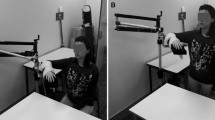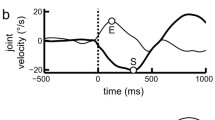Abstract
It is a common experience, immediately after the removal of a cast or a splint, to feel motor awkwardness, which is usually attributed to muscular and joint immobilization. However, the same feeling may also be perceived after a brief period of immobilization. We provide evidence that this last effect stems from changes in the cortical organization of the focal movement as well as in the associated anticipatory postural adjustments. Indeed, these two aspects of the motor act are strongly correlated, although scaled in different manners. In fact, they are both shaped in the primary motor cortex, they both undergo similar amplitude and latency modulation and, as we will show, they are both impaired by the immobilization of the lone prime mover. Neuromuscular effects of limb immobilization are well known; however, most papers focus on changes occurring in the pathways projecting to the prime mover, which acts on the immobilized joint. Conversely, this study investigates the effect of immobilization on anticipatory postural adjustments. Indeed, we show that 12 h of wrist and fingers immobilization effectively modify anticipatory postural adjustments of the elbow and the shoulder, that is, those joints not immobilized within the fixation chain. Accordingly, the motor impairment observed after short-term immobilization most likely stems from the unbalance between anticipatory postural adjustments and the focal movement.



Similar content being viewed by others
References
Allison T, McCarthy G, Wood CC (1992) The relationship between human long-latency somatosensory evoked potentials recorded from the cortical surface and from the scalp. Electroencephalogr Clin Neurophysiol 84:301–314
Aruin AS, Shiratori T (2004) The effect of the amplitude of motor action on anticipatory postural adjustments. J Electromyogr Kinesiol 14:455–462
Avanzino L, Bassolino M, Pozzo T, Bove M (2011) Use-dependent hemispheric balance. J Neurosci 31:3423–3428
Baldissera F, Esposti R (2005) Postural constraints to coupling of ipsilateral hand-foot movements. NeuroReport 16:1615–1619
Baldissera F, Borroni P, Cavallari P, Cerri G (2002) Excitability changes in human corticospinal projections to forearm muscles during voluntary movement of ipsilateral foot. J Physiol 539:903–911
Bey L, Akunuri N, Zhao P, Hoffman EP, Hamilton DG, Hamilton MT (2003) Patterns of global gene expression in rat skeletal muscle during unloading and low-intensity ambulatory activity. Physiol Genomics 13:157–167
Bortolami SB, Pigeon P, Dizio P, Lackner JR (2008) Kinetic analysis of arm reaching movements during voluntary and passive rotation of the torso. Exp Brain Res 187:509–523
Brown JE, Frank JS (1987) Influence of event anticipation on postural actions accompanying voluntary movement. Exp Brain Res 67:645–650
Caronni A, Cavallari P (2009a) Anticipatory postural adjustments stabilise the whole upper-limb prior to a gentle index finger tap. Exp Brain Res 194:59–66
Caronni A, Cavallari P (2009b) Supra-spinal circuits shape inhibitory postural adjustments anticipating voluntary index-finger flexion. Exp Brain Res 198:19–28
Cavallari P, Fournier E, Katz R, Pierrot-Deseilligny E, Shindo M (1984) Changes in reciprocal Ia inhibition from wrist extensors to wrist flexors during voluntary movement in man. Exp Brain Res 56:574–576
Clark BC, Taylor JL, Hoffman RL, Dearth DJ, Thomas JS (2010) Cast immobilization increases long-interval intracortical inhibition. Muscle Nerve 42:363–372
Crone C, Hultborn H, Mazières L, Morin C, Nielsen J, Pierrot-Deseilligny E (1990) Sensitivity of monosynaptic test reflexes to facilitation and inhibition as a function of the test reflex size: a study in man and the cat. Exp Brain Res 81:35–45
Esposti R, Baldissera FG (2011) Combined recruitment of two fixation chains during cyclic movements of one arm. Hum Mov Sci 30:213–226
Facchini S, Romani M, Tinazzi M, Aglioti SM (2002) Time related changes of excitability of the human motor system contingent upon immobilization of the ring and the little fingers. Clin Neurophysiol 113:367–375
Ghez C, Gordon J, Ghilardi MF (1995) Impairments of reaching movements in patients without proprioception. II. Effects of visual information on accuracy. J Neurophysiol 73:361–372
Gordon J, Ghilardi MF, Ghez C (1995) Impairments of reaching movements in patients without proprioception. I. Spatial errors. J Neurophysiol 73:347–360
Hather BM, Adams G, Tesch P, Dudley G (1992) Skeletal muscle responses to lower limb suspension in humans. J Appl Physiol 72:1493–1498
Hortobàgyi T, Dempsey L, Fraser D, Zheng D, Hamilton G, Lambert J, Dohm L (2000) Changes in muscle strength, muscle fibre size and myofibrillar gene expression after immobilization and retraining in humans. J Physiol 524:293–304
Huber R, Ghilardi MF, Massimini M, Ferrarelli F, Riedner BA, Peterson MJ, Tononi G (2006) Arm immobilization causes cortical plastic changes and locally decreases sleep slow wave activity. Nat Neurosci 9:1169–1176
Józsa L, Kannus P, Thöring J, Reffy A, Järvinen M, Kvist M (1990) The effect of tenotomy and immobilisation on intramuscular connective tissue. A morphometric and microscopic study in rat calf muscles. J Bone Joint Surg Br 72:293–297
Kaminski TR, Bock C, Gentile AM (1995) The coordination between trunk and arm motion during pointing movements. Exp Brain Res 106:457–466
Katz R, Pénicaud A, Rossi A (1991) Reciprocal 1a inhibition between elbow flexors and extensors in the human. J Physiol 437:269–286
Kim SW, Shim JK, Zatsiorsky VM, Latash ML (2009) Anticipatory adjustments of multi-finger synergies in preparation for self-triggered perturbations. Exp Brain Res 174:604–612
Kudina L, Ashby P, Downes L (1993) Effects of cortical stimulation on reciprocal inhibition in humans. Exp Brain Res 94:533–538
Langer N, Hänggi J, Müller NA, Simmen HP, Jäncke L (2012) Effects of limb immobilization on brain plasticity. Neurology 78:182–188
Lee WA, Buchanan TS, Rogers MW (1987) Effects of arm acceleration and behavioral conditions on the organization of postural adjustments during arm flexion. Exp Brain Res 66:257–270
Liepert J, Tegenthoff M, Malin JP (1995) Changes of cortical motor area size during immobilization. Electroencephalogr Clin Neurophysiol 97:382–386
Moisello C, Bove M, Huber R, Abbruzzese G, Battaglia F, Tononi G, Ghilardi MF (2008) Short-term limb immobilization affects motor performance. J Mot Behav 40:165–176
Petersen TH, Rosenberg K, Petersen NC, Nielsen JB (2009) Cortical involvement in anticipatory postural reactions in man. Exp Brain Res 193:161–171
Pozzo T, Stapley PJ, Papaxanthis C (2002) Coordination between equilibrium and hand trajectories during whole body pointing movements. Exp Brain Res 144:343–350
Sainburg RL, Ghilardi MF, Poizner H, Ghez C (1995) Control of limb dynamics in normal subjects and patients without proprioception. J Neurophysiol 73:820–835
Seki K, Taniguchi Y, Narusawa M (2001a) Effects of joint immobilization on firing rate modulation of human motor units. J Physiol 530:507–519
Seki K, Taniguchi Y, Narusawa M (2001b) Alterations in contractile properties of human skeletal muscle induced by joint immobilization. J Physiol 530:521–532
Veldhuizen JW, Verstappen FT, Vroemen JP, Kuipers H, Greep JM (1993) Functional and morphological adaptations following four weeks of knee immobilization. Int J Sports Med 14:283–287
White MJ, Davies CT, Brooksby P (1994) The effects of short-term voluntary immobilization on the contractile properties of the human triceps surae. J Exp Physiol 69:685–691
Acknowledgments
This study was supported by “F.I.R.S.T.” grants from the Università degli Studi di Milano, Italy.
Author information
Authors and Affiliations
Corresponding author
Rights and permissions
About this article
Cite this article
Bolzoni, F., Bruttini, C., Esposti, R. et al. Hand immobilization affects arm and shoulder postural control. Exp Brain Res 220, 63–70 (2012). https://doi.org/10.1007/s00221-012-3115-7
Received:
Accepted:
Published:
Issue Date:
DOI: https://doi.org/10.1007/s00221-012-3115-7




